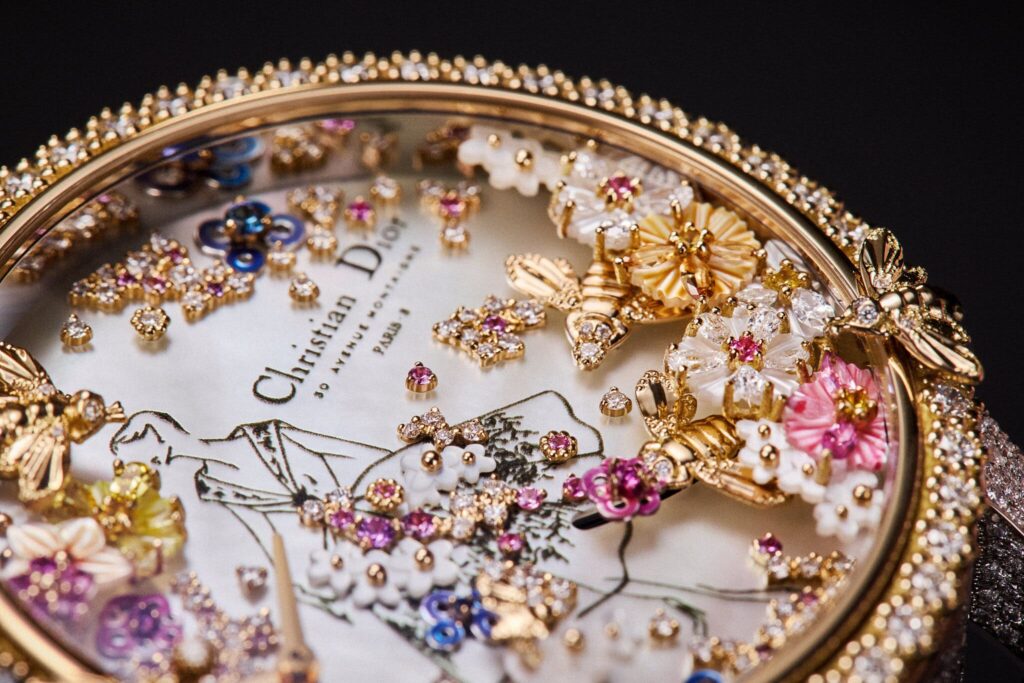

Luxury watchmaking has undergone a profound transformation over the decades. Traditionally, opulence in haute horology was defined by the presence of lavish gemstones, with brands competing to create the most dazzling, diamond-encrusted timepieces. While the brilliance of precious stones continues to captivate collectors, there has been a noticeable shift in what constitutes the ultimate expression of luxury.
In today’s horological landscape, connoisseurs are increasingly valuing intricate craftsmanship, heritage techniques, and artistic mastery over sheer extravagance. The emphasis is now placed on watchmaking artistry, where techniques such as enameling, guilloché, miniature painting, and hand-engraving elevate timepieces into the realm of wearable masterpieces.
The Historical Allure of Gem-Set Timepieces
The association between luxury watches and gemstones has deep roots in history. For centuries, jeweled timepieces were the domain of royalty and the elite, symbolizing wealth, power, and status. The meticulous craft of gem-setting requires not only selecting high-quality stones but also the precision to enhance a watch’s beauty without compromising its function.
Royal Patronage and Early Jeweled Watches
The origins of gem-set watches trace back to the Renaissance, when aristocrats and monarchs commissioned extravagant timepieces encrusted with diamonds, rubies, emeralds, and sapphires. These early watches, often pocket watches or pendants, were as much decorative ornaments as they were functional devices.
During the 18th and 19th centuries, European watchmakers like Breguet, Vacheron Constantin, and Patek Philippe catered to royal courts, creating watches adorned with elaborate gemstone arrangements. Queen Marie Antoinette, known for her love of extravagant accessories, famously commissioned a highly complex Breguet watch, which featured an array of luxurious materials.
Modern Gem-Set Timepieces: A Fusion of Haute Joaillerie and Haute Horlogerie
In contemporary watchmaking, brands such as Chopard, Harry Winston, and Graff have continued this tradition, producing some of the most elaborate gem-set watches. These timepieces blur the lines between haute joaillerie and haute horlogerie, combining precious stones with mechanical precision.
•Chopard’s Haute Joaillerie Collection features watches adorned with exquisitely cut diamonds, sapphires, and rubies, set in breathtaking patterns.
•Harry Winston, often referred to as the “King of Diamonds,” creates timepieces that celebrate the brilliance of its signature gemstones, elevating jewelry watches to an art form.
•Graff’s Hallucination, one of the most expensive watches ever created, showcases an unprecedented array of rare colored diamonds, set in an intricate mosaic pattern.
While these watches remain the epitome of luxury, the modern collector’s perspective has broadened. The focus is shifting toward the artistry behind the timepiece rather than just the value of its materials.
The Resurgence of Artisanal Craftsmanship in Watchmaking
As collectors become more discerning, the appreciation for traditional craftsmanship has surged. Techniques that require meticulous skill, patience, and artistic mastery—such as enameling, miniature painting, and guilloché—are making a strong comeback. These elements transform a watch from a mere accessory into a cultural artifact, embodying centuries-old traditions.
Enameling: A Fusion of Art and Alchemy
Enameling is one of the most revered decorative techniques in watchmaking, requiring an extraordinary level of expertise. This intricate process involves fusing powdered glass onto a metal surface through multiple firings at high temperatures (often exceeding 800°C). The result is a vivid, durable, and lustrous surface.
Cloisonné and Grand Feu Enamel
•Cloisonné enamel involves using gold wires to create compartments (cloisons), which are then filled with enamel. Each color is fired separately, making it a painstakingly slow process.
•Grand Feu enamel, meaning “great fire,” is among the most difficult techniques, as multiple layers of enamel are fired at extremely high temperatures to create deep, radiant colors.
Ulysse Nardin, one of the few brands to master this technique, acquired Donzé Cadrans, a specialist enameling workshop, ensuring that their timepieces maintain an unmatched level of craftsmanship. Their limited-edition cloisonné enamel dials showcase intricate oceanic themes and celestial motifs, each requiring weeks of meticulous handcrafting.
Miniature Painting: Capturing the World in Microcosm
Miniature painting is another rare technique that transforms a watch dial into a canvas for storytelling. Using a fine brush and an extraordinarily steady hand, artisans paint intricate scenes inspired by nature, mythology, and historical art.
Brands such as Bovet Fleurier and Vacheron Constantin have mastered this technique, producing timepieces that feature hand-painted dials depicting everything from famous artworks to exotic landscapes. Each watch is a one-of-a-kind masterpiece, taking dozens of hours to complete.
Guilloché: The Dance of Light and Geometry
Guilloché, a decorative engraving technique, involves cutting precise, repetitive patterns onto a watch dial or case using a hand-operated lathe. The result is a mesmerizing, light-reflecting effect that enhances the timepiece’s aesthetic complexity.
Breguet, one of the pioneers of guilloché, continues to incorporate this technique into its dials, ensuring that each pattern is unique. The brand’s signature “Clous de Paris” motif, a fine hobnail pattern, has become a hallmark of sophisticated watch design.
The Modern Collector’s Perspective: Beyond Material Value
Today’s watch collectors seek timepieces that offer a compelling narrative—whether through historical craftsmanship, rare artistic techniques, or mechanical innovation. The value of a watch is increasingly measured by its uniqueness, the expertise of the artisans who created it, and the story it tells.
Personalization and Exclusivity
Luxury brands are responding to this shift by offering bespoke services, allowing clients to personalize their timepieces. Custom enameling, hand-engraved initials, and unique dial paintings have become popular among collectors who desire exclusivity.
Patek Philippe’s Rare Handcrafts Collection showcases watches that integrate intricate enamel work, guilloché, and hand-engraving, blending artistry with mechanical mastery.
Independent Watchmakers and Artisanal Innovation
The rise of independent watchmakers has also contributed to the resurgence of craftsmanship-focused horology. Brands like F.P. Journe, Kari Voutilainen, and Greubel Forsey are gaining recognition for their dedication to traditional techniques, often producing watches in extremely limited numbers to maintain the highest level of craftsmanship.
Balancing Gemstones and Craftsmanship: The Future of Luxury Watches
While the appreciation for artisanal techniques continues to grow, it does not necessarily diminish the allure of gem-set watches. Instead, the future of luxury watchmaking lies in the harmonious integration of both elements.
High-end brands are finding ways to combine exquisite artistry with precious materials:
•Jaeger-LeCoultre’s Rendez-Vous collection incorporates both gem-setting and miniature painting, demonstrating how opulence and artistry can coexist.
•Vacheron Constantin’s Les Cabinotiers line features highly customized watches that merge fine engraving, enameling, and gem-setting to create one-of-a-kind masterpieces.
Sustainability and Ethical Sourcing
Another emerging trend in haute horology is the ethical sourcing of materials. Consumers are increasingly demanding transparency regarding the origins of gemstones and precious metals. Brands such as Chopard and Cartier have committed to using Fairmined gold and ethically sourced diamonds, ensuring that luxury does not come at the expense of environmental or social responsibility.
The Future of Haute Horology
The world of luxury watchmaking is entering a new era—one that values heritage, craftsmanship, and artistry as much as it does rare materials. While gem-set timepieces will always hold their place as symbols of opulence, the growing appreciation for intricate watchmaking techniques is redefining the meaning of true luxury.
Ultimately, the future of haute horology lies in the balance between tradition and innovation, where mechanical mastery, artistic expression, and refined elegance come together to create timepieces that transcend time itself.
No comments yet.









